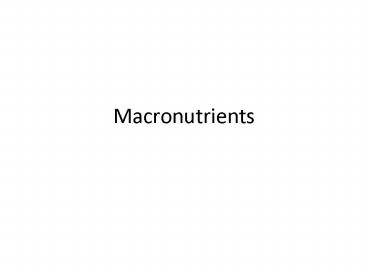Macronutrients - PowerPoint PPT Presentation
1 / 14
Title:
Macronutrients
Description:
Macronutrients Learning Goals for Digestion By the end of this chapter, you will be able to: Explain the anatomy of the digestive system Explain the importance of ... – PowerPoint PPT presentation
Number of Views:163
Avg rating:3.0/5.0
Title: Macronutrients
1
Macronutrients
2
Learning Goals for Digestion
- By the end of this chapter, you will be able to
- Explain the anatomy of the digestive system
- Explain the importance of digestion in providing
nutrients needed for energy and growth - Describe the types of nutrients necessary for
energy and growth - Describe disorders related to the digestive system
3
Key Terms
- Macronutrient nutrient needed in large amounts
of in our diet - Micronutrient nutrient needed in small amounts
in our diet - Polymer molecule made up of many subunits
- Monomer a subunit of a polymer
- Condensation reaction (dehydration synthesis)
reaction in which monomers are joined, with water
as a byproduct - Catalyst speeds up a reaction without being
consumed in the reaction - Enzyme protein catalyst. Enzymes often end in
the suffix -ase, eg. DNA polymerase (enzyme
that makes DNA polymers) - Hydrophobic water fearing (not water soluble)
- Hydrophillic water loving (water soluble)
4
Macro and Micro Nutrients
- Macronutrients (Macromolecules)
- Carbohydrates
- Proteins
- Lipids
- Nucleic Acids (will not be discussed until grade
12) - Micronutrients
- Vitamins
- Minerals
5
Carbohydrates
- Monosaccharides
- Single sugars
- Eg. Glucose, fructose, dextrose
- Disaccharides
- Combination of two monosaccharides
- Eg. Sucrose, lactose, maltose
- Polysaccharides
- A polymer of many monosaccharides
- Eg. Glycogen, amylose (starch), cellulose, chitin
6
Formation of di/poly saccharides
- Dehydration Synthesis (Condensation Reactions)
- Additional monosaccharides can be added, creating
polysaccharides.
Woohoo, Im free
7
Lipids
- Fats, Oils and Waxes (depending on the state at
room temperature) - Made of triglycerides (glycerol and three fatty
acids) - Glycerol fatty acids are condensation reactions
8
Fatty Acids
- Hydrocarbon chain in the fatty acid can either be
saturated (containing only single bonds) or
unsaturated (containing one or more double bonds
between carbons)
9
Lipids
- Phospholipids
- Steroids
- Amphiphillic molecules containing glycerol, 2
fatty acids, and a polar head
- Multi-ringed molecules often used as chemical
messengers (hormones) - Eg. Cholesterol, testosterone, progesterone
10
Proteins
- Made of chains of amino acids
- There are 20 different amino acids (8 are
essential) - Each amino acids has an amino group, a carboxyl
group and a unique portion called the R-Group
11
Polypeptides
- Many amino acids join together (via dehydration
synthesis reactions) to form polypeptides (the
bond between two amino acids is called a peptide
bond)
12
Vitamins
- Organic molecules required in tiny amounts by an
organism
Vitamin Fat/Water soluble Role
A Fat Good vision, healthy skin and bones
B Water Metabolism, growth, muscle tone, energy
C Water Collagen and bone formation, teeth and gums, blood vessels, immune system
D Fat Calcium absorption, bone formation
E Fat Strengthens red blood cells, antioxidant
K Fat Used in the blood clotting pathway
13
Minerals
- Inorganic trace elements required in small amounts
Mineral Role (may have other roles not listed here)
Potassium Systemic electrolyte, nervous impulses
Chlorine Hydrochloric acid in stomach
Sodium Systemic electrolyte, nervous impulses
Calcium Muscle, heart, digestive health, bones, synapses
Phosphorus Component of bone, energy processing, component of DNA/RNA
Magnesium Bones, ATP processing
Zinc Needed for the proper functioning of many enzymes (cofactor gr 12)
Iron Blood (carries oxgyen/carbon dioxide), other proteins
Manganese Enzyme cofactor
Copper Needed for redox reactions in metabolism (cytochrome C)
Iodine Used to make thyroid hormones (eg. Triiodothyronine)
Selenium Enzyme cofactor
Molybdenum Enzyme cofactor
14
Formative Quiz
- Take out a piece of paper (1/2 page is fine)
- Identify the molecule you see on the slide
- Be as specific as possible








![[DOWNLOAD]⚡️PDF✔️ The Everything Guide to Macronutrients: The Flexible Eating Plan for Los PowerPoint PPT Presentation](https://s3.amazonaws.com/images.powershow.com/10085856.th0.jpg?_=20240725107)

![[DOWNLOAD]⚡️PDF✔️ The Everything Guide to Macronutrients: The Flexible Eating Plan for Losing Fa PowerPoint PPT Presentation](https://s3.amazonaws.com/images.powershow.com/10073839.th0.jpg?_=20240705071)

![[READ] The Everything Guide to Macronutrients: The Flexible Eating Plan for Losing Fat and Getting Lean (Everything® Series) PowerPoint PPT Presentation](https://s3.amazonaws.com/images.powershow.com/10081642.th0.jpg?_=20240719081)


















